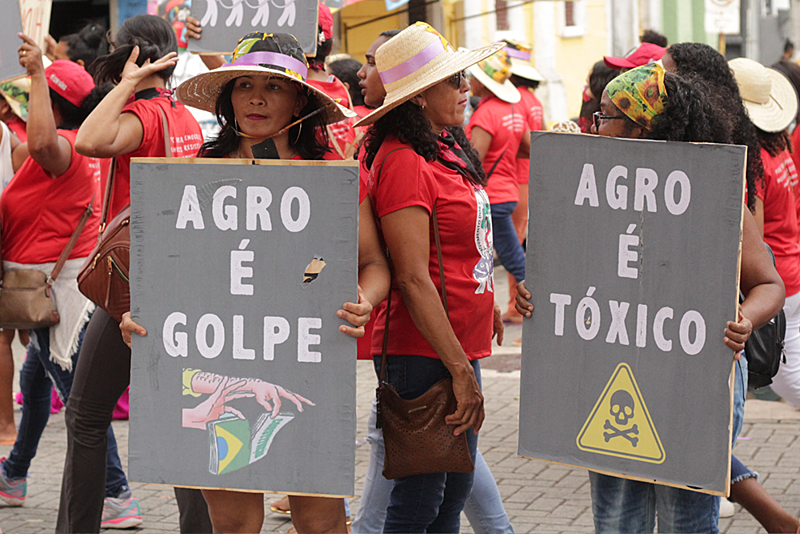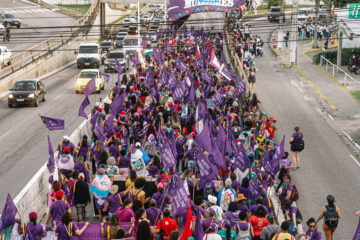This century’s environmental crisis is directly connected to the agribusiness model based on large rural properties and single-commodity crops. Intensive, predatory production ravaging rural areas is basically anchored in deforestation perpetrated in the Brazilian Amazon and Cerrado, two of the most biodiverse regions on the planet. In an era of growing concern over climate change and sustainability, the green economy, green capital, and the carbon market emerge as “concepts” in the pursuit of environmentally responsible and “viable” solutions.
The Landless Workers’ Movement (MST) website interviewed Larissa Ambrosano Packer to address the dynamics between agribusiness and the environment, discussing aspects including new capitalist technologies in the organization of agriculture, and the expressions of the financialization of the economy in the land and environmental dynamics. Packer is a socio-environmental lawyer holding a master’s degree in Philosophy of Law. She is also a member of the Grain team for Latin America.

Does the green economy, which seems to be “trending” these days, provides solutions for the problem of the global environmental crisis?
This relationship between capital markets, agribusiness, and the environment is part of this trend where institutional investors are aiming at generating billions of dollars around the world, aiming at the highest possible profitability for the “rent-seeking elites,” both individuals and businesses. I am talking about BlackRock, Vanguard, State Street, Global Advisors, which manage trillions of dollars—sometimes greatly exceeding the GDP of the United States or China. When these professional institutional investors face the oscillations of the capital markets, inflationary movements, and drops in interest rates, they seek physical assets, tangible, physical goods, like real estate, transport infrastructure, ports, airports, and precious metals like gold, farmlands, and natural resources in general.
This alliance of institutional investors in the capital markets and these physical, tangible assets is pretty much connected to moments of crisis, both as a strategy to protect their money against inflation, and to have this super accumulation of money attached to some physical basis that can guarantee long-term profitability that is safer than the traditional financial assets, like stocks and government bonds. This is connected to this moment where there is a race for gold, land, and real estate, which has been increasing in the past 15 years, since the 2008 mortgage crisis in the United States, which also generated a huge volume of financial capital with no ballast to land on, and which ultimately led to roughly three great movements.
What are these movements?
Grain has documented an increase in international businesses involving land from 4 million hectares to 45 million hectares in 2009 over 2008. This is what the literature has called land grabbing—a race for farmlands that was ultimately endorsed by the World Bank in 2011.
In 2012, for example, there were several institutional investors looking to buy businesses that manage farmlands in the US to put this super accumulation of capital in a limited land market. This resulted in skyrocketing land prices—one hectare in Wisconsin reached $67,000. To give you an idea, in 2021 these so-called real assets—which are actually the real estate market, both for commercial and residential purposes—represented 51 percent of all of the world’s current assets, or $290 trillion.
The second largest market is the debt instrument market, and it is not even half of that value ($123 trillion); and the third largest market is the gold market. It is also a very sought-after asset in times of crisis, as it provides more safety and protection against the corrosion of money in inflationary times, and it is a $12-trillion market.
Also, according to AGBI Real Assets, a real asset manager, rural properties represent more than $35 trillion, which is roughly 6 percent of the world economy’s assets. In the past 20 years, farmlands have appreciated by 300 percent.
Combined, these real estate funds that invest in commercial, residential, and rural properties add up to more than $320 trillion, which is roughly four times the world GDP in 2020. So there is now an alliance between financial investors, agribusiness, and natural resources in this time of increasing financial crisis, as they aim to protect themselves from the corrosion of money in face of inflation, while also seeking greater profitability and distribution of dividends among investors and rent-seeking elites.
How is all this race for capital impacting countries’ lands and common goods?
It especially impacts countries that have farmlands and natural resources. This super accumulation of capitals is moving toward these other geographies in the Global South, where there are abundant lands and natural resources. Many institutional investors pursue a super appreciation of these assets, increasing the price of land and agricultural commodities, which ultimately impacts food prices and the access to land and common goods that are provided by the land, like water, biodiversity, native vegetation, and environmental quality and integrity, which are human rights connected to the dignity of life and health, for humans as well as animals and the planet.
In times of financial crisis, these financial investors use this environment of super concentration and shortage to introduce previously common goods in the legal framework of private property—and, even worse, in the financial framework. They bring these common goods not only closer to the legal framework of the commodity, but to financial assets as well. They subject goods that were previously common goods—like land, water, and natural resources—to the interests of the distribution of dividends among fund investors. This means that, the more agribusiness expands, producing few commodities with low nutritional quality for export, with more deforestation and land and water grabbing, the higher the pricing of these real-assets-turned-financial-assets, and the greater the distribution of dividends among these asset managers and these global rent-seeking elites. This ultimately subjects common goods and the interests of the population to a strategy aimed at providing financial gains for few families, the world’s few super-rich.
Is this the so-called green economy?
“Green economy” is more of a slogan to legitimize or popularize interests that are class-based interests restricted to a small rent-seeking elite and those financial agents that work for them. So you involve class interests and promote them as if they were everyone’s global, bigger interests.
The hegemonic narrative claims to want a green economy in which these investors help the planet and help all populations to raise funds for low-impact environmental projects. But this claim is used precisely to hide the fact that it is an economy for the rent-seeker, the capitalist, the financial investor who more and more wants increasing profitability based on rising land, commodity, and food value.
The result is a minority of owners and majorities of people with no access, no home, no land, which leads this access to increasingly become part of the value composition of these goods, more and more connected to these investors’ interest in achieving higher profitability.
While they may claim these resources will be used for the sake of the planet, the pursuit of greater profitability is intrinsic to the dynamics of financial investments. Greater profitability is connected to deals where land is bought at low prices and sold at high prices.
It is no coincidence that there are many reports of these land asset managers, including pension funds, involved in deals in which they buy land at very low prices in the MATOPIBA [acronym for Maranhão, Tocantins, Piauí, and Bahia, a Brazilian region encompassing these states], which are low-priced precisely because their chain of title is contaminated with vice and fraud through the forgery of land ownership [grilagem] of public and collective lands. Then, after a few years, they are no longer degraded pasture land and become soy monocrops, degraded for different reasons, to produce export-oriented commodities. This rises the value of the land and, when it is sold, the profits are distributed among a few financial investors.
There is this whole dynamics of higher pricing or appreciation of these lands, and those with no money are driven to sell their lands. There is concentration of land, displacement of populations and small farmers, traditional peoples and communities, increasing deforestation, and so on. When you really watch the phenomenon of capital connected to the so-called green economy, what you see is a brown economy, an economy that leads to serious violence against people and the environment.
In 2008, with the super accumulation of capital with no ballast to land on after the mortgage crisis in the US, there is a capital flight and a search for new markets, new assets, safer for these trillions of dollars to land on. And there were roughly three phenomenons: land grabbing, with a global race for land around the world, especially in the countries in the Global South; financial speculation in agricultural commodities, with a concentration, by a few funds, of soybean and corn futures contracts, etc, leading to booming food prices; and autonomous economic appreciation, referring to land and environmental values.
There used to be environmental quality or integrity, as part of the legal framework of common goods. These goods could not be taken by one person and they could not be traded like any other commodity, precisely because they were intended for everyone, present and future generations. Now there is an economic appreciation for the private property framework, allowing some actors to issue land titles on what they are starting to call environmental services or ecosystem services.
Can you elaborate on that?
Today this is already a principle in environmental law, but an entire trade market is actually built through pricing and authorizing contracts and circulation of new commodities around environmental goods, which are now considered real assets that can be traded like any other commodity, especially in the financial assets environment.
In Brazil, the environmental reserve quota (cota de reserva ambiental—CRA), which is one hectare of native vegetation in any stage of regeneration, does not require a primary or secondary forest—it can be a degraded area or one that is regenerating now. It is providing an environmental service of carbon sequestration through growing, letting that area regenerate and grow.
So with these territories, you can issue financial bonds traded in stock exchanges and over the counter. Likewise, Nasdaq and the California Stock Exchange have also included water as a financial asset, which is then also priced and traded in stock exchanges—and then they start talking about water quotas.
We’re watching common goods that belonged to everyone move to the private property framework and, not only that, become a financial asset. This can be conducive to deforestation. Including environmental management in the logic of supply and demand, in the logic of market pricing, can lead to very dangerous speculative movements against the environment. The logic is: the larger the wildfires in California or Pantanal, and the lower the volumes of available, scarce water, the highest the value of that quota in the stock exchange. And those who hold these quotas will have greater profitability and will start to trade them for higher values in the secondary market. Similarly, environmental reserve quotas in places where mining operations, agribusiness, soybean, cotton, and corn monocrops are greatly expanding will have fewer areas of forests or native, protected vegetation, and the higher the value of these quotas will be. This has nothing to do with environmental protection. We are talking about financial economy, and there is nothing green about it.




